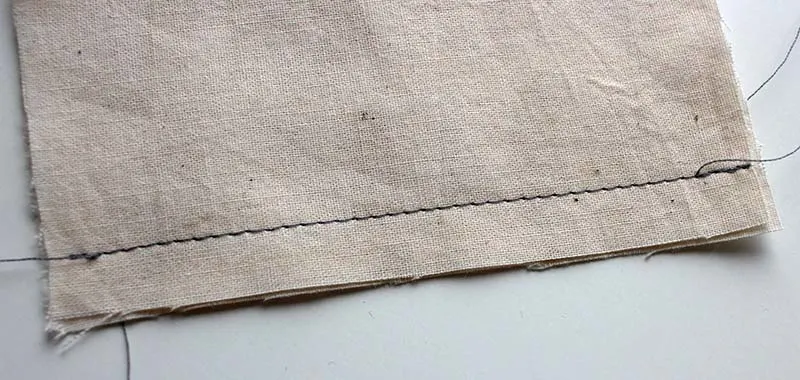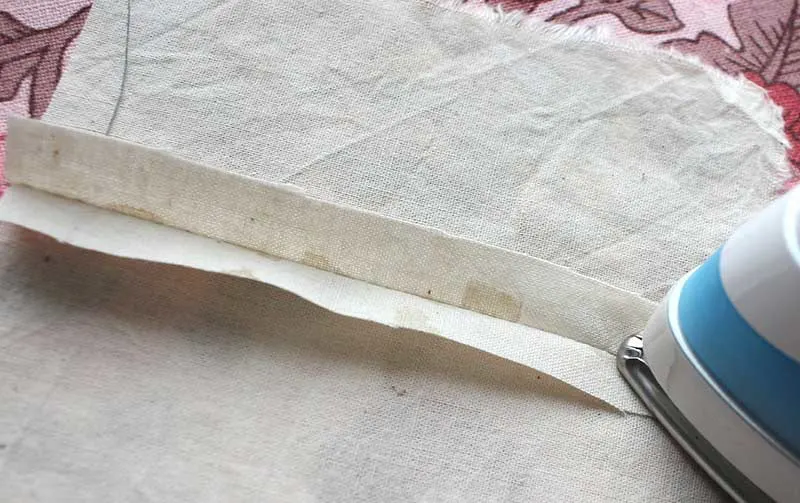I covered an overview of the open seam finish in my guide to different seam types, but I wanted to expand on that with this quick and easy sewing tutorial – which is perfect for sewing beginners wanting to know how to sew an open seam!
I recommend reading through this whole open seam tutorial first, to familiarise yourself with the steps, and then go back through the sewing tutorial with me, sewing as you go.
And if you prefer video, I have an open seam video tutorial at the bottom of this article.
Now, before we get started on sewing an open seam, let’s take a quick look at some frequent questions sewing beginners ask me!

What Is The Difference Between A Seam And A Stitch?
Now, this is a question often posed from people who have never sewn a stitch before, and while many of you reading this will be rolling your eyes because you know the answer, I’m still going to explain the difference for those sewing beginners who want to ask but worry they’ll look daft doing so.
- A stitch is created using one or more threads and a needle.
- A seam is created by connecting two or more pieces of fabric together, usually with stitches.
How Do You Make A Seam?
Making a seam is quite straightforward. As we’re talking specifically about sewing seams, in order to create a seam you would need to sew through two or more pieces of fabric to connect them. This leaves an allowance to one side of the stitch line, which is known as the seam allowance.
You can make a seam sewing by hand or by using a sewing machine. And your seams can be straight or curved.
If you’re not sure how to use a sewing machine, check out my free online sewing course over on YouTube – it’s the perfect course for sewing beginners!
How Much Is Seam Allowance?

Seam allowance varies depending on the seam you are sewing. For this open seam sewing tutorial, we will be using a standard amount of seam allowance.
For me (UK / EU based) that is 1cm, though most commercial sewing patterns will tell you to use 1.5cm or 5/8 inch for your seam allowances.
Ultimately, when you are creating your own sewing patterns, you get to choose, but if you start out using commercial sewing patterns, you are restricted to using the seam allowance included in them, I’m afraid, unless you want to go to the hassle of trimming it down.
What Are The Types Of Seams
Very quickly, as I have covered the different types of seams in more detail previously, here are the six most commonly used seam types:
- Open seam / plain seam
- French seam
- Welt seam
- Flat Felled seam
- Lapped seam
- Piped seam
In this post, we’ll cover the five steps to sewing an open seam (also called a plain seam!), but there will be other easy sewing tutorials too for the other seam types.
Open Seam vs Plain Seam: What is the Difference?
Both open seam and plain seam are almost the same thing and are often used interchangeably. But, if we’re getting specific about open seams, here’s the difference:
- Plain seam: a simple seam that has been stitched and pushed to one side.
- Open seam: a simple seam that has been stitched and then pressed open.
Here’s a photo of a plain seam. Typically, the seam allowance at the bottom is ‘pushed to one side’ for a plain seam…

And here’s a photo of an open seam, where the seam allowances has been ‘opened’…

Now, as most sewing pattern instructions call for seams to be pressed open, this is the term most frequently used.
A plain seam though – one that isn’t pressed open – would be used for sewing anything that doesn’t ask for the seam to be pressed open. Make sense?
What Is An Open Seam Used For?
An open seam is used all the time in sewing. The most obvious locations:
- Side seams on skirts
- Side seams on trousers / pants
- Side seam down underarm and side seam of shirt
- Tailoring
Open seams usually require some kind of seam finishing to prevent them from unravelling.
What Is A Plain Seam Used For?
The plain seam, when not pressed open, is used when:
- Attaching facings to waistbands and necklines so that the seam can be ‘under stitched’ which helps the facing lay neatly on the wrong side
- Attaching collars to collar stands or necklines
- Attaching sleeves to armholes
- Attaching cuffs to sleeves
And many more!
What Is Seam Finishing?
Seam finishing is the term used to explain how the edge of the seam allowance is ‘finished’ or tidied up.
Different ways that seams can be finished include:
- Pinked seam allowances using pinking shears
- Serged or overlocked edges
- Zigzag edges
- Enclosed (this can be as a French seam or felled seam, or bound with bias binding or banding)

I’ll cover seam finishings in another post soon, but for now, just know that the edges of your seam allowances are what seam finishings really refer to!
What Is A Serged Seam?
A serger seam is a plain seam – not an open seam! – created by ‘serging’ two or more pieces of fabric together in one go. The serger or overlocker ‘wraps’ the edge of the fabric in stitches, creating a serged plain seam. This seam gets left as is or pushed to one side.
How Does An Open Seam Work?
The great thing about an open seam is that it spreads the seam allowance evenly to either side of the seam-line. This is very important when sewing heavier weight fabrics, as having two ‘pieces’ of seam allowance, as well as the self-fabric all in one area, can cause a lot of bulk.
Here’s a photo of an open seam in light cotton, which helps to minimise bulk. Notice how you cannot see the seam allowance through the fabric? That’s because it isn’t bulky! 🙂

You’ll notice that bulk is what happens if a ‘plain seam’ seam is used and the seam allowances are simply pushed to one side! An open seam limits that bulkiness.
If you are sewing several sections together that have already been sewn with open seams, then further open seams can drastically help further reduce bulk!
What Do I Need To Sew An Open Seam?
If you’re planning on sewing open seams, you’ll need the following basic sewing tools:
- Sewing machine / sewing needle
- Fabric scissors
- Fabric
- Pins
- Thread
- Seam gauge (not essential)
- Iron
- Press cloth
For my recommended list of basic sewing tools, check out this sewing tools list for sewing beginners!
How To Sew An Open Seam In Five Steps
Here’s a quick overview of the five steps needed to sew an open seam, but I’ll go more in-depth below with photos as well!
- Finish the raw edges of your two pieces of fabric.
- Place the right sides of the fabric pieces together.
- Sew a stitch line with chosen seam allowance amount down the length of the fabric pieces.
- Press the seam with a steam iron to ‘set the stitches’.
- Press the seam ‘open’ – one seam allowance to one side, and one seam allowance to the other!
Pretty easy right? Doesn’t sound nearly as scary as sewing beginners think!
If you’re completely new and have never even sewn a line of stitches, go check out this post first on how to sew straight and curved lines with a sewing machine.
Step 1: Finishing Raw Edges For An Open Seam
Your first step is to decide how you want the raw edges of your fabric to be finished. This is the part we read above called ‘Seam Finishing’.

In the example above, I have used a simple zigzag stitch on my sewing machine to limit how much the fabric edges will fray in the future.
In the photo below, you can see that the zigzag stitch has somewhat prevented the fraying of the woven fabric at the points of the zigzags.

I do not believe that the zigzag stitch is the best method for finishing fabric edges, but for sewing beginners who do not have an overlocker or serger, nor the experience of sewing enclosed seams, then the zigzag stitch edge finish is a great starting point!
Step 2: Place Right Sides Of Fabric Together
Now, when it comes to fabric, there’s a right side and a wrong side. Here’s the wrong side of my fabric below, and then further below that, the right side of my fabric.

The wrong side of my fabric in the photo above only *just* shows the ink from the right side.

And the photo above of the right side of my fabric looks pretty much the same – except for the hand-painted detail!
If you’re a sewing beginner, choosing a simple cotton with a print on it will help because you’ll be more able to see the difference.
As you get more experience sewing, you’ll ‘see’ the difference more readily on plain fabrics.
For now, place the two pieces of fabric’s right sides together and pin into place.

Step 3: Sew Your Stitchline With Chosen Seam Allowance
Now that you have your two pieces of fabric together, place them carefully under the sewing foot on your sewing machine. (If you need some help with sewing machine parts, head to this post to learn about the different parts of a sewing machine!)
You can use a seam gauge to keep the seam allowance equal and sew slowly down the length of fabric. I usually sew with minimal pins and rely on the sewing plate guidelines.
Don’t be worried about whether your sewing is wonky. You can practice sewing in a straight line with this tutorial too!

Step 4: Setting The Stitches
You now want to grab your steam iron – I keep this small travel version nearby for speedy use! – and ‘set’ the stitches in place.
This is done with a little bit of steam, and depending on your fabric choice, you may need a pressing cloth to prevent damage.

Step 5: Pressing The Seams Open
The final step for sewing an open seam is to press those seam allowances on your new seam ‘open’. To do this, I like to ‘finger press’ the seam open to make sure the seam allowances are where they should be before I bring in the hot iron.

Then I use the tip of the iron to help press the seam allowances open.

Pressing your seams is a really important part of sewing, as it ensures that your sewing looks professional by avoiding ‘bouncy’ seams!
You can see from the two images below that the open seam I sewed was crisp and neat. A great open seam in fact!


Open Seam Video Tutorial
How did you find that? Does the process of sewing and pressing your open seam make sense? Have a go, and let me know how you get on in the comments below!

Barbara Harris
Sunday 19th of January 2020
Hi Eve Tokens! I am not brave enough to sew clothes yet! For some reason it just scares me! Your tutorial is great and very informative! I will definitely bookmark this for future use!
I am giving away a fat quarter bundle on my blog today! I would love for you to come over and enter! Happy New Year!
Casey
Thursday 10th of October 2019
What do you do if the seam won’t stay open flat and keeps lifting back up?
Coreena
Thursday 9th of May 2019
In your post above, you didn't finish the edges of your seam. In the beginning of the lesson you explained this. But in the finished picture you didn't do it. Do how would you finished the edges after already sewing the open seam? Would you attempt to sew the edges after the fact somehow? or rip the seam out and start over.
Eve Tokens
Thursday 9th of May 2019
Oooh Coreena! That was sharp spotting! When editing the photos I realised that I didn't finish the raw edge first before sewing the seam, so added in the photo I had taken! Alas - there was I hoping no-one would notice! ;) So, the decision would be based on how much seam allowance you have. If you has between 5-7.5mm I would unpick and sew again! If it was greater than 7.5, you can get away with a small width zigzag stitch to finish the edge. However, if you planned to finish the raw edges using an overlocker / serger, I would *always* say to unpick and start again. It's just too tetchy with that pesky overlocker / serger blade!